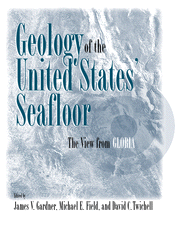Introduction
Published online by Cambridge University Press: 25 January 2010
Summary
On the fog-shrouded morning of April 26, 1984, the USGS research vessel Farnella unceremoniously slipped its berth in San Diego, California, to begin one of the nation's greatest mapping expeditions ever undertaken. The mission was to map the newly declared territories of the United States – the Exclusive Economic Zone (EEZ). The U.S. EEZ was proclaimed just a year earlier by then-President Ronald Reagan. This single stroke of the presidential pen increased the size of the U.S. territory by more than 100%, a much larger increase in area than occurred with the Louisiana Purchase in 1803. Just as the area gained by the Louisiana Purchase was a region little explored, the more than 13 million km2 of seafloor represented a vast terra incognita (Figure 1). The 1879 Organic Act of the U.S. Geological Survey (USGS) provides a mandate for the USGS to map the territorial lands of the U.S., and mapping the EEZ was a natural extension of that mandate. However, how to map this vast region became a problem. It was clear from the beginning that the mapping budget would not be comparable to those set aside to map the Moon, Mars, or Venus. Yet, just a year after the proclamation, and in the tradition of the late nineteenth-and early twentieth-century USGS mapping expeditions of the West, a USGS team ventured forth to map the newly acquired national lands of the EEZ.
- Type
- Chapter
- Information
- Geology of the United States' SeafloorThe View from GLORIA, pp. 1 - 4Publisher: Cambridge University PressPrint publication year: 1996
- 1
- Cited by



